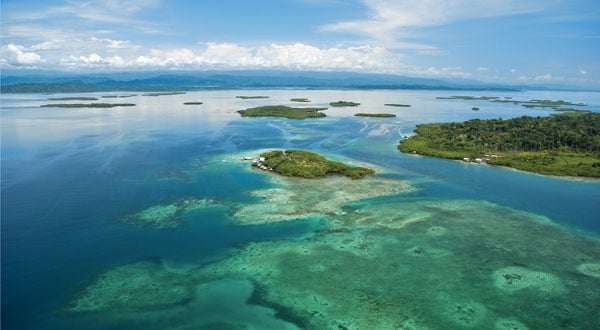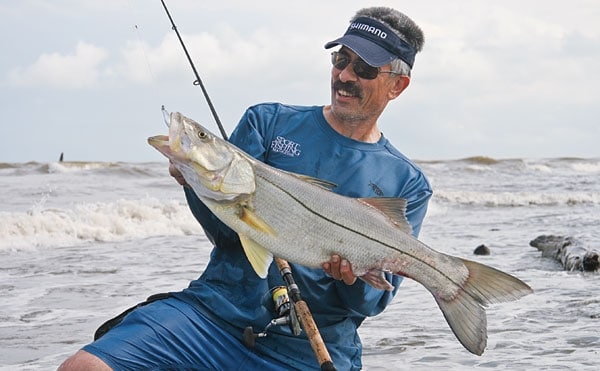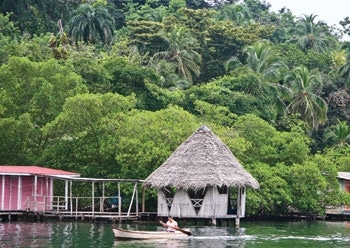
Fishing Panama is mostly a very one-sided affair, that being its Pacific side. A number of fine fishing resorts on that coast offer world-class action, as is well known internationally.
Not surprisingly, few anglers who fly to Panama to fish these productive waters give the country’s Atlantic coast, to the north, a second thought. After several trips to fish Panama, its northern coast wasn’t on my radar screen either – until I happened to find tranquilobay.com. Seeing aerial photographs of the Caribbean Sea’s southernmost pocket, around Bocas del Toro, changed everything.
Back in Time
Months after that discovery, I found myself on an Aeroperlas ATR commuter plane that had departed Panama City an hour earlier. Now, as it neared Bocas del Toro, I looked down to see what those aerial images on my monitor had promised: mile after mile of untouched mangrove islets interlaced with channels and bays, and interspersed with many sprawling river mouths. Around each, the muddy outflow created a patch of brown water flowing into the clear Atlantic. Beyond and nearby, reefs sparkled in transparent Caribbean waters.
Seeing so much varied habitat all within an hour or so run of Tranquilo Bay Eco Adventure Lodge, located about an hour west/northwest of Panama City on Isla Bastimentos, speaks volumes about the varied game fish along with fishing options and opportunities that await anglers here. Also, there’s what you don’t see: anyone else, at least fishing recreationally. It’s easy to feel that you have the whole coast to yourself.
View Fishing Panama’s Forgotten Coast in a larger map
Then too there’s precious little commercial activity in the area, save for small artisanal fishermen, mostly fishing from cayucos (wooden canoes) or wooden skiffs with small outboards. All this makes for the sense, when fishing out of Tranquilo Bay, of a separation not merely geographic but also temporal – like stepping back in time to fish a coast as it had been a century before.
Lures and Liveys for Tarpon
The biggest draw here for many anglers is sure to be the outstanding tarpon and snook fishing. Any angler who knows these prized game fish of inshore tropical waters is sure to equate their availability with the all-too-rare phrase “unspoiled river mouths.”
“We fish several river mouths,” says Jim Kimball who, along with partner and fellow Texan Jay Viola, spent the years from 2000 to 2006 building with their own initiative, persistence and sweat the remarkable lodge at Tranquilo Bay. Some rivers in the area don’t empty directly into the Caribbean, but into the expansive Laguna de Chiriqui. While these “inside” river mouths can be productive at times, as long as the weather and seas are favorable for fishing outside, Kimball and Viola prefer to work the outside river mouths that surge directly into the ocean since that’s where tarpon typically stack up.
“Just up the coast, we can fish three different river mouths, starting with the closest, the Changuinola,” Kimball says, which is where he usually starts. Both Kimball and Viola, keen anglers themselves, enjoy being the resort’s fishing guides in a 25-foot SeaVee with 200 hp Yamaha. Their usual modus operandi involves drifting outside the river mouth, putting live baits on circle hooks beneath balloons on a couple of rods while anglers cast artificials (plugs or soft plastics) from the bow.
The live bait are small grunts – hardy, effective and always available. That availability is ensured by a local woman who comes by the net pen at the resort’s dock daily to feed the 100 or so lively grunts she keeps stocked in the pen.
Kimball says it’s not unusual to see hundreds of tarpon rolling at times, “but even when you don’t see them, they’re here. They’re here all year. And these aren’t small fish, either,” averaging 75 pounds or so. They’ve released tarpon well over the 150 mark and have hooked much larger.

Snook in the Surf
Abundant snook, particularly larger fish, can be tough to find throughout their range. I think the species’ susceptibility to netting often leaves populations made up mostly of small fish. That doesn’t appear to be the case in many of the 50 or so coastal rivers between Bocas and Colon. Multiple strikes and multiple catches characterize most anglers’ experiences out of Tranquilo Bay, either by casting from the boat or, often, wading the surf zone. Most of these snook run 7 or 8 to at least 15 pounds, but again, larger fish have been caught and certainly lurk in this habitat so favored by the species.
Viola’s tackle box for snook contains mostly white bucktail jigs, as well as various soft plastics and some topwater plugs. He acknowledges that these snook are targeted rarely and only by Tranquilo Bay fishermen, and many lures remained untested. Indeed, I opted for a flashy Spanyid Maniac spoon in the turbid water (roiled by a rough ocean the day I waded the mouth of the Changuinola), and a 15-pound snook seemed to like it just fine. “When they’re there and they’re biting, I suspect it doesn’t matter too much what you throw,” says Viola.
For anglers targeting snook, river mouths are the place to go. Picking up snook in other habitats is rare.
Also inshore, around some of the windward islands, schools of small bonefish can spice up a morning, and while permit don’t seem to be prevalent, Kimball has seen some monsters while snorkeling.
Speaking of monsters, the big bull and hammerhead sharks often common wherever schools of tarpon reside seem strangely — and thankfully — absent here. “We’ve never yet lost a tarpon to a shark,” Kimball says.
However, snapper do frequent the river mouths at times. “In one day, fishing the same area of a beach, I caught a tarpon around the 100-pound mark, a 20-pound dogtooth snapper and a 30-pound snook,” says Chris Dawson of Manhattan, Kansas, a repeat angler at Tranquilo Bay. Dawson has fished throughout the Caribbean, and says the variety of fishing options and species here make Tranquilo Bay his favorite.
Unexplored Reefs
While no huge banks — á la Zane Grey or Hannibal on the Pacific side — loom from the bottom of the Caribbean Sea off Bocas, there are many humps and bumps in 100 to 300 feet of water before the continental shelf slopes steeply away. And a glance at a nautical chart (28041, Approaches to Bocas Del Toro) reveals a stunning array of reefs and structure pockmarking the area just off Crusapin Point, 24 miles southwest of Tranquilo Bay.
These reefs remain mostly unexplored by anglers, Kimball says. Unseasonable north winds prevented us from making drifts there to try the substantial selection of metal jigs we’d brought. In fact, we made it offshore for about an hour one morning before the wind started howling, just long enough for me to miss a wahoo and land a 15-pound mutton snapper.
Kimball points out that “those reefs get zero pressure.” Other than a few locals with hand lines, “no one fishes them,” Kimball says. Though on occasion he takes Tranquilo Bay anglers out to fish the reefs, in fact, their potential has yet to be tapped. Besides muttons, anglers are likely to encounter such species as yellowtail, dog and cubera snapper, black grouper and some industrial-size kingfish.
Where these reefs drop off into deeper waters, blackfin and school-size yellowfin tuna, wahoo and dolphin (mahi) might lurk. Kimball and Viola have had some memorable catches pulling large Rapala CD Magnums well offshore.
The Atlantic coast of Panama is truly a place of many options, both on land and for those on the water with so many varied habitats. As noted previously, in one morning you can catch not only good-size tarpon, snook and snapper in the surf, you can then go offshore for grouper and pelagic game fish. No matter which direction you go, the odds of seeing any other recreational fishing boat will be slim to none. That’s likely to change as more anglers discover the potential of Panama’s Caribbean side, but for now it remains a largely forgotten coast.
Tripping to Tranquilo

Getting there: 1) Fly into Panama City (PC) from many U.S. cities via several carriers. We’ve had good luck with Copa (copaair.com), which offers the convenience of direct (nonstop) flights into PC from New York (JFK), Los Angeles, Washington, D.C. (Dulles), Miami and Orlando (note that at press time, checking fishing rods in a case longer than 5 feet will entail a $75 charge each way); 2) Fly from PC to Bocas Del Toro, about an hour on a prop-driven commuter plane. Aeroperlas (aeroperlas.com) offers the convenience of two flights in/out most days. Time your flights right and, if you’d like, you might be able to avoid the necessity of an overnight stay in PC; and 3) Jim and/or Jay will meet you at the Bocas airport; from there, they’ll take you and your gear the half-hour run in one of the resort’s outboard boats to Tranquilo Bay.
When to go: While there’s no “bad” time to visit this Caribbean milk-and-honey land, when serious fishing is the goal, the choices are clear: spring and fall. Specifically, April, May, September and October are normally hands-down the best choices. Not only are most game fish most active then, seas tend to be flat, day in, day out, Kimball says.
What to bring: The resort has tackle, and while it might suffice, I’d recommend bringing some of your own rods/reels appropriate to the species that you most want to catch (keeping in mind the inshore and offshore fisheries). Ditto for lures. Any of your favorites are likely to produce; unlike more-discriminating fish in heavily fished areas, these have not seen many artificials.
What to expect: Great food — of course — great company, a well-stocked bar, and accommodations in air-conditioned cabins that offer solitude and privacy. The resort’s water, ultrafiltered and UV-treated, is absolutely drinkable. The hospitable main lodge itself offers always-available high-speed Internet as well as a U.S. land line with a Houston area code.
More to do: For you and/or your family, keep in mind that Tranquilo Bay offers a great deal of options beyond fishing. Guided jungle/mountain/beach hikes with the resort’s full-time naturalists, snorkeling gin-clear reefs, visiting indigenous villages, surfing, bird-watching, and kayaking mangroves and white-water rivers are among the options here, many of which fall within the popular umbrella of “eco-tourism.”
For reservations or more information: www.tranquilobay.com; 713-589-6952.








